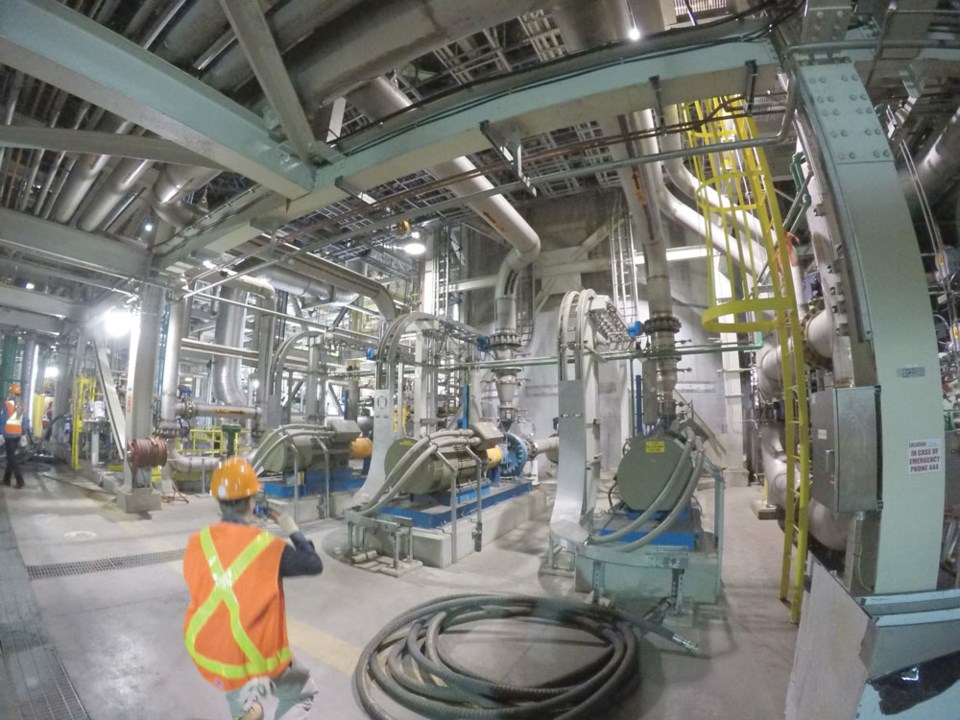The Boundary Dam Unit 3 Integrated Carbon Capture and Storage Project (BD3) has had its share of bugs that gathered many headlines since it went online in October 2014, but SaskPower has expended great effort in addressing those issues and sorting out what needed to be fixed. On May 11, as a part of the Carbon Capture Summit, hosted by the Estevan Chamber of Commerce, the Crown corporation laid out just what some of those issues have been, and what steps they’ve taken to address them.
David Jobe, who holds a PhD in Chemistry and is licensed as an engineer, gave the presentation on behalf of SaskPower. He’s the director of carbon capture and chemical services at Boundary Dam Power Station.
“We are operating very well,” he said of the current situation.
He outlined several phases that took place over roughly 2.5 years the plant has been operational. It started out with optimism, when the plant held its grand opening on Oct. 2, 2014. But during the commissioning phase, which ran until April 2015, he noted, “It became apparent these were not typical design issues.”
In particular, they had issues with fly ash and amine, what is essentially the chemical lifeblood of the capture plant.
“We were getting a lot of fouling and plugging,” he said.
One of the key issues was the original design had no redundancy. So when they had to clear fouling from a system, they had to shut the whole plant down every time something plugged.
Fly ash related outages accounted for a significant amount of time the plant was down.
The plant’s steam de-superheater’s original design was unable to cool the steam sufficiently, and this affected the amine, causing degredation.
Dirty heat exchangers, without redundancy, meant shutdowns when they needed to be cleaned. There were also component deficiencies. He noted small carbon steel gaskets that needed to be replaced.
Then there was the leaking amine tank, a ceramic brick structure which had tens of thousands of hand-placed tiles lining it. It leaked. They tried a number of fixes, but eventually had to open up the roof and lower in a close-fitting cylindrical stainless steel tank inside the original tank, taking its place.
Overall, ash-related problems resulted in 42.6 per cent of the down times, the CO2 compressor was 19.2 per cent, construction deficiencies made up 14.9 per cent, and outages with the power generating unit accounted for 13.5 per cent. Miscellaneous items made up the final 4.8 per cent.
Jobe then got to the fixes addressing these issues. It was found that a spray curtain would deal with much of the fly ash. “It was a breakthrough,” he said.
The de-superheater was replaced. The amine was purified. Deficient materials and a heat exchanger were replaced. They installed rectifiers on the power plant’s precipitators.
For 2015, the plant had a 56 per cent availability as they worked through these issues and captured 426,066 tonnes of carbon dioxide. However, they were able to hit the 3,240 tonne per day nameplate capacity for a period of 72 hours.
The goal for 2016 was to hit 800,000 tonnes of captured carbon dioxide, and 85 per cent reliability. By May and June of that year, there were issues with the CO2 tower and degradation of the amine, causing foaming like soap. By adding anti-foaming agents, they dealt with that problem.
Activated carbon was added in 2017, and that worked well. Its addition meant a jump in production over the course of four hours from 1,400 tonnes per day to 1,800 tonnes per day. By the end of the year, they had captured 808,263 tonnes of carbon dioxide and had 84 to 85 per cent online availability. This resulted in CO2 emissions, from the entire system, of 380 tonnes per gigawatt-hour, whereas the regulator limit is 420 tonnes per gigawatt-hour.
Putting in redundant systems should bring availability up to 90 per cent, or more, according to Jobe.
On the agenda is a significant shutdown later this spring which will coincide with a regular maintenance shutdown of the power generating unit. At some point following that, SaskPower intends on running a 720 hour test, capturing more than 3,000 tonnes per day. At 2,800 tonnes per day, the resultant emissions would equate to around 200 tonnes per gigawatt-hour.
“It was a rough and rocky start. We had the privilege of being first.” Jobe concluded.




